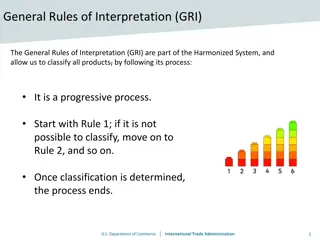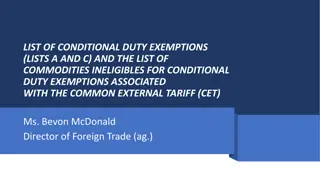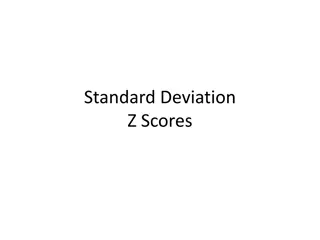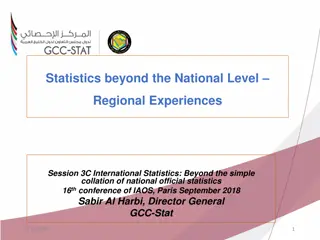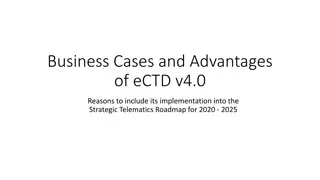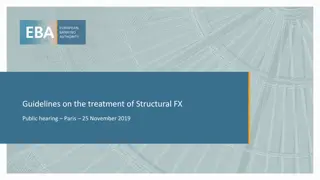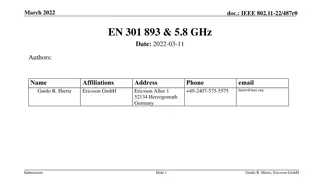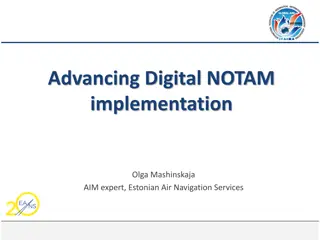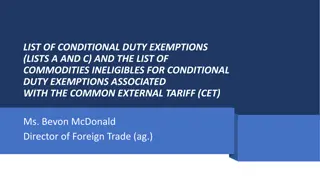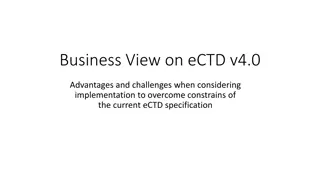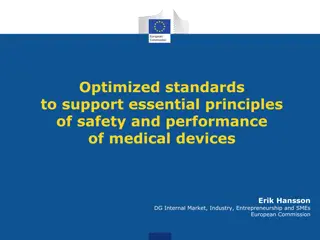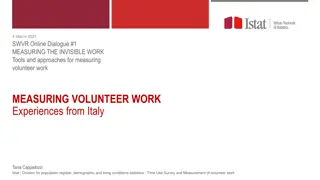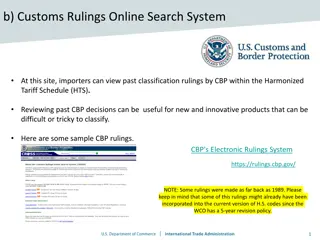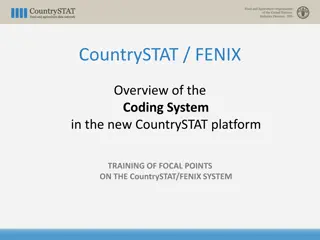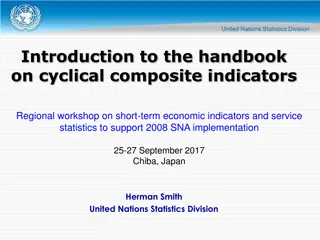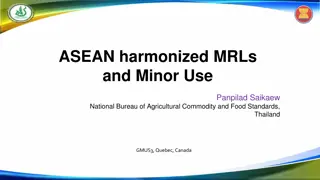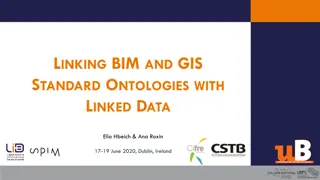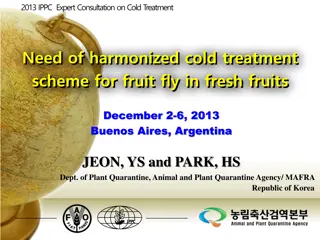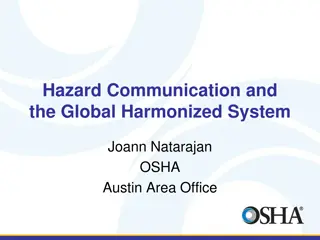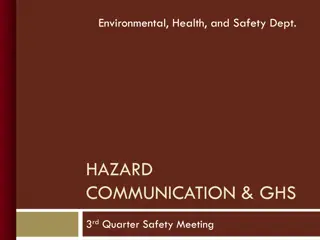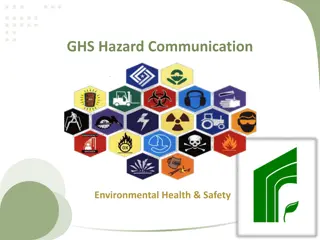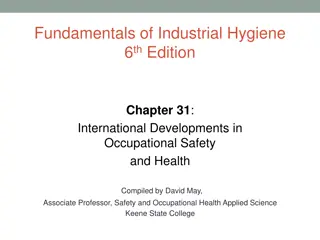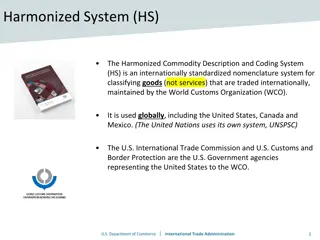Benefits of Coordinating Monetary Transfers for Beneficiaries
Coordinating monetary transfers provides various advantages for beneficiaries, including scalability, increased resources, speed, reduced duplication, improved targeting, better referral networks, enhanced links with social protection systems, improved communication, and harmonized approaches. This
4 views • 16 slides
Future Tasks in AV Certification and Harmonization Overview
Assessment of current achievements and future tasks in the certification of Automated Vehicles (AVs) is discussed by experts from CLEPA and OICA. The focus is on the ADS certification overview, potential improvements for harmonization, and the need for harmonized AV definitions to enhance regulatory
3 views • 7 slides
CEPT Workshop on 6G Mobile Communications: Numbering & Network Issues
CEPT Workshop on 6G Mobile Communications, led by Elizabeth Greenberg of Ofcom UK, addresses the role of numbering and networks in the ECC, numbering considerations for 6G, and how WG NaN contributes to the development of numbering for 6G technologies. Key topics include ensuring non-discriminatory
1 views • 8 slides
Advancing Circular Economy Through Flexible Packaging Initiative
Flexible Packaging Initiative is driving a circular economy in Europe by emphasizing the importance of flexible packaging, showcasing key benefits, and outlining steps to ensure circularity in the recycling value chain. The initiative supports harmonized sorting labels, eco-modulated fees, and the p
5 views • 5 slides
General Rules of Interpretation (GRI) in the Harmonized System
The General Rules of Interpretation (GRI) are essential for classifying products under the Harmonized System. Starting with Rule 1 and progressing to subsequent rules if needed, the process determines classification based on headings, notes, mixtures, and more. Products are classified based on speci
1 views • 5 slides
Understanding Conditional Duty Exemptions and the Harmonized System
This information delves into the concept of conditional duty exemptions associated with the Common External Tariff (CET) and the Harmonized System (HS). It explains the structure of the Schedule of Rates based on the HS, the application of duty rates in CARICOM, and the lists of items ineligible for
0 views • 16 slides
Understanding Standard Deviation, Variance, and Z-Scores
Explore the importance of variation in interpreting data distributions, learn how to calculate standard deviation, understand z-scores, and become familiar with Greek letters for mean and standard deviation. Discover the significance of standard deviation in statistical analysis and the difference b
1 views • 18 slides
Enhancing Regional Integration Through Statistical Collaboration in the GCC
Regional statistics play a crucial role in informing regional policies, monitoring progress, and assessing developmental outcomes. The Gulf Cooperation Council (GCC) has established GCC-Stat as a regional statistics center to meet statistical requirements at the GCC level. By improving regional data
7 views • 8 slides
Workplace Exposure Standard for Silica Dust in Stone Benchtop Fabrication
Reduction in workplace exposure standard for respirable crystalline silica dust has been implemented, halving the national standard to 0.05 mg/m3. The new standard aims to protect workers in stone benchtop fabrication businesses from serious lung diseases caused by breathing in silica dust. Employer
1 views • 8 slides
The Advantages of Implementing eCTD v4.0 into the Strategic Telematics Roadmap
eCTD v4.0 offers several benefits such as harmonized submission units, document re-use through unique identifiers, enhanced life cycle management, and controlled vocabularies for easier updates. It facilitates grouping of documents based on context of use and keywords, automates administrative proce
0 views • 13 slides
Enhancing Corporate Accountability through Human Rights Due Diligence
European Coalition for Corporate Justice emphasizes the importance of Human Rights Due Diligence (HRDD) as a mechanism for preventing human rights abuses and improving access to justice. The lack of harmonized HRDD obligations in the EU hinders corporate accountability. Implementing effective HRDD l
0 views • 8 slides
Guidelines on Treatment of Structural FX Provision in Banking Sector
The guidelines focus on ensuring a harmonized interpretation and implementation of the structural FX provision in the Capital Requirements Regulation (CRR). It discusses the scope of applicability, provisions on currencies for which waivers are sought, and minimum requirements for positions to be co
9 views • 10 slides
Revolutionizing Phytosanitary Certificates Exchange with ePhyto Solution
This cutting-edge ePhyto Solution project aims to streamline the electronic exchange of phytosanitary certificates globally. By introducing a harmonized set of rules, it facilitates interactions among developing and developed countries, reducing paperwork, costs, and delays associated with manual pr
0 views • 22 slides
Overview of IEEE 802.11-22/487r0 and EN 301.893 Harmonized Standard
This document discusses the March 2022 version of IEEE 802.11-22/487r0, focusing on the EN 301.893 Harmonized Standard. It covers the confidentiality aspects, accessibility of draft standards, and the implications for manufacturers in the European Union market. The latest version, 2.1.47 of the HS,
5 views • 10 slides
Advancing Digital NOTAM Implementation: Evolution and Future Trends
The evolution of digital NOTAM implementation from its establishment in 1993 to the current focus on structured data sets for accurate and efficient updates in the aeronautical environment. The transition from text-based NOTAM to digital formats addresses the need for timely and reliable aeronautica
0 views • 9 slides
Overview of Conditional Duty Exemptions and Ineligible Commodities under CET
The Harmonized System, administered by the WCO, forms the basis for the Schedule of Rates in the CET. Conditional Duty Exemptions allow goods to be imported duty-free or at reduced rates for specific purposes, subject to approval. Certain commodities are deemed ineligible for duty exemptions, based
0 views • 16 slides
Advantages and Challenges of Implementing eCTD v4.0 to Overcome Constraints
Embracing eCTD v4.0 offers advantages like harmonized rules, simplified life cycle activities, improved automation, and reusability of submitted documents. While the benefits are substantial, challenges such as evaluating cost-benefit ratios, ensuring compatibility with evolving IT systems, and adap
0 views • 5 slides
Optimized Standards for Medical Device Safety and Performance in the EU
This report discusses the importance of harmonized standards in supporting the safety and performance of medical devices in the EU. It highlights the impact of drafting international medical device standards on EU legislation harmonization and emphasizes the role of harmonized standards under the EU
0 views • 8 slides
European Standards for Plant Biostimulants Development
The European Committee for Standardization (CEN) plays a crucial role in developing European standards for plant biostimulants, focusing on improving plant nutrition processes independently of nutrient content. The CEN/TC.455 committee is responsible for creating standards supporting the EU Fertilis
2 views • 5 slides
Experiences in Measuring Volunteer Work: Insights from Italy
Tools and approaches for measuring volunteer work in Italy, including experiences with different survey platforms and harmonized sources. The adoption of the ILO Manual on the Measurement of Volunteer Work and the importance of collaboration between official statistics and the third sector for accur
0 views • 7 slides
System-Wide Action Plan for Gender Equality Implementation
The System-Wide Action Plan (SWAP) adopted by the United Nations provides a unified framework to measure progress towards gender equality and women's empowerment. UN entities are expected to meet the set performance standards by 2017, ensuring accountability and harmonized reporting on gender issues
0 views • 30 slides
CBP Rulings Online: Explore Classification Decisions for Imports
Importers can access past classification rulings by CBP in the Harmonized Tariff Schedule (HTS) to aid in classifying new and innovative products. Reviewing CBP decisions is valuable, especially for complex items like submersible ROVs used in the oil and gas industry. By checking historical rulings,
1 views • 4 slides
Overview of Coding Systems in CountrySTAT/FENIX
Explore the detailed coding systems within the CountrySTAT/FENIX platform including Central Product Classification, Harmonized Commodity Description, and more. Learn how to use the coding systems to create tables and manage data effectively for economic analysis and decision-making.
0 views • 29 slides
Enhancing Accessibility Testing with ACT Rules for WCAG
Explore how harmonized accessibility tools and the Accessibility Conformance Testing (ACT) Rules are improving consistency and transparency in testing accessibility according to WCAG standards. Discover challenges, implementations, and benefits of utilizing ACT for a more trustworthy WCAG testing pr
1 views • 7 slides
Handbook on Cyclical Composite Indicators Overview
This content provides insights into cyclical composite indicators, their objectives, features, and importance in economic analysis. It emphasizes the need for harmonized principles and standards in compiling these indicators for better international comparisons and economic assessments. The handbook
0 views • 23 slides
ASEAN Harmonized MRLs and Minor Use Overview
Explore the establishment of ASEAN harmonized Maximum Residue Limits (MRLs) and the current situation in agricultural cooperation, covering topics such as risk assessment, collaboration structures, and the way forward. Gain insights into the importance of MRL adoption, Codex regulations, and pestici
0 views • 11 slides
Understanding the Key Articles of the Nagoya Protocol on Access to Genetic Resources and Benefit-Sharing
The Nagoya Protocol aims to promote fair sharing of benefits from genetic resources utilization for conservation efforts. It encompasses access, technology transfer, funding, and respect for rights over resources and technologies. The protocol applies to genetic resources, traditional knowledge, and
1 views • 19 slides
Linking BIM and GIS Standard Ontologies with Linked Data
Introduction to the need for seamless data interpretation between Building Information Model (BIM) and Geographic Information System (GIS), focusing on aligning BIM and GIS standard ontologies for semantic interoperability. Addressing the challenges of data interoperability layers and the characteri
0 views • 15 slides
Harmonized Cold Treatment Scheme for Fruit Fly in Fresh Fruits Expert Consultation
The 2013 IPPC Expert Consultation in Buenos Aires, Argentina discussed the need for a harmonized cold treatment scheme for fruit flies in fresh fruits. The goal was to control regulated pests in international trade and suggest experiments for harmonizing cold treatment protocols. Prohibited articles
0 views • 13 slides
Guidelines for Harmonized System Classification of Goods
Understand the step-by-step process of classifying goods under the Harmonized System, including referencing section notes and chapter notes, resolving ambiguities in word meanings, identifying essential characteristics of unfinished goods, choosing specific headings over general ones, and classifyin
0 views • 41 slides
Development of Harmonized North American Life Jacket Standards
The development of harmonized North American life jacket standards led by Brandi Baldwin in the Lifesaving & Fire Safety Division at the Office of Design & Engineering Standards is a crucial regulatory process. It involves regulatory progress, standards development, consensus processes, and ongoing
0 views • 16 slides
Understanding Hazard Communication and the Global Harmonized System
This content discusses the changes introduced by the Global Harmonized System in Hazard Communication Standards (HCS). It highlights the impact on classifications, labels, safety data sheets, and information and training requirements. The GHS aims to enhance workplace safety by providing a standardi
0 views • 37 slides
Global Harmonized System (GHS) in Hazard Communication and Safety
The Global Harmonized System (GHS) establishes a uniform classification and labeling of chemicals to ensure effective communication of hazards globally. Developed to improve chemical management and safety, GHS aims to provide consistent protection and reduce regulatory burdens. Adopted international
0 views • 60 slides
Understanding GHS: The Globally Harmonized System of Classification and Labeling of Chemicals
The Globally Harmonized System (GHS) is a standardized approach to classifying and labeling chemicals, offering workers the right to understand hazards. It enhances cross-border communication, reduces confusion, and ensures consistent information. Major changes in GHS labels and Safety Data Sheets i
0 views • 17 slides
Importance of Hazard Communication Training for Workplace Safety
Hazard communication training is essential for creating a safe work environment by helping individuals recognize and manage hazardous materials effectively. Understanding the Globally Harmonized System (GHS) and following hazard communication laws can improve workplace safety, protect human health,
0 views • 36 slides
Global Harmonized System of Classification and Labeling of Chemicals (GHS) Overview
The Global Harmonized System of Classification and Labeling of Chemicals (GHS) was developed to address the inconsistencies in hazard information for chemicals globally due to significant trade. The history, mandate, and provisions of GHS, along with additional domestic harmonization efforts, are di
0 views • 29 slides
Understanding the Harmonized System (HS) for International Trade
The Harmonized System (HS) is an internationally standardized nomenclature system for classifying goods traded internationally, managed by the World Customs Organization (WCO). It organizes goods into categories down to the 6-digit level, providing a common set of descriptive categories for global t
0 views • 10 slides
Understanding Standard Molar Enthalpies of Formation
Formation reactions involve substances being created from elements in their standard states, with the enthalpy change known as the standard molar enthalpy of formation (Hf). This enthalpy represents the energy released or absorbed when one mole of a compound is formed from its elements in their stan
0 views • 13 slides
Rainbow-Inclusive Workplaces Standard: Promoting Diversity in Employment
The Rainbow-Inclusive Workplaces Standard (NZS 8200:2015) is a groundbreaking initiative in New Zealand, setting guidelines for organizations to create inclusive and safe workplaces for individuals of diverse sexual orientations and gender identities. The standard aims to address discrimination and
0 views • 30 slides
Understanding Standard Deviation and Standard Error of the Means
Standard deviation measures the variability or spread of measurements in a data set, while standard error of the means quantifies the precision of the mean of a set of means from replicated experiments. Variability is indicated by the range of data values, with low standard deviation corresponding t
0 views • 7 slides




